U.S. Department of Transportation
Federal Highway Administration
1200 New Jersey Avenue, SE
Washington, DC 20590
202-366-4000
Federal Highway Administration Research and Technology
Coordinating, Developing, and Delivering Highway Transportation Innovations
|
Research & Technology Transporter This newsletter is an archived publication and may contain dated technical, contact, and link information. |
|
| Publication Number: N/A Date: May 2004 |
Publication Date: May 2004
|
Highway agencies need accurate measurements of roadway geometry and roadside hardware for applications ranging from reconstruction projects to pavement improvement programs and asset management databases. In addition, the agencies also may require accurate road geometry to plan corrective measures for high-incident locations on older roads, especially when original construction plans are not available. Often, agencies also need assessments of pavement surfaces to design and inspect construction projects. To obtain this information, they rely on tools, such as sensors that evaluate pavement smoothness, or manual techniques, such as surveying. But to conduct tests using these procedures, transportation specialists sometimes need to stop traffic, creating congestion and safety hazards.
Researchers at the Federal Highway Administration’s (FHWA) Turner-Fairbank Highway Research Center (TFHRC) currently are developing a Digital Highway Measurement (DHM) vehicle that includes several instruments to measure roadway geometry and assess pavement conditions. The instruments in the van are the most accurate, state-of-the-art sensors available, and they are all off-the-shelf items. The vehicle can collect data while traveling at normal highway speeds, making it possible to conduct tests without disrupting traffic. The computers inside the vehicle can store up to one day’s worth of data.
To collect data on highway geometry, the DHM vehicle is equipped with the same high-resolution inertial navigation unit, or guidance system, that airplane pilots use to determine their precise locations. The vehicle also uses a high accuracy nationwide differential geographic positioning system (HA-NDGPS) unit. Though currently undergoing further research and development, HA-NDGPS will offer greater navigational accuracy than traditional GPS. By comparing the data obtained from both systems, researchers at FHWA hope to determine whether future DHM vehicles can use less expensive GPS equipment instead of more costly aircraft guidance systems.
In addition, FHWA has mounted stereoscopic cameras on the front of the van to collect high-resolution videos of the roadway and its features, such as lane markings, signs, and guardrails. The vehicle also is equipped with lasers to gather data on pavement texture and edge conditions, and a temperature gauge to record road surface temperatures. In future phases of the project, the researchers plan to install additional instruments, including cameras that face downward to record data on pavement cracks, potholes, and joint conditions, and radar to collect data on roadside hardware, vegetation, and terrain up to 15.25 meters (50 feet) from each side of the vehicle.
FHWA researchers are using the DHM vehicle in several field tests. For example, researchers are working with the Pennsylvania Department of Transportation (DOT) on a project to conduct research on the retroreflectivity of pavement markers and improve road safety in rural areas. The DHM vehicle will collect geometry and roadside data on a road section with multiple curves. Researchers will use the data from the Pennsylvania road to create a model of the roadway for the highway driving simulator at TFHRC. This project represents a significant improvement in the ability of researchers to compare real-world roadway data with vehicle simulator data. The researchers will observe test participants driving on the actual road, and then driving the simulated version of the road, to determine if they behave similarly in both situations.
In another experiment, the researchers will use the DHM vehicle to collect geometry data for a 19.3-kilometer (12-mile) section of Virginia Route 9, providing the Virginia DOT with data necessary to perform an as-built analysis of the corridor. At another site, FHWA will compare the data gathered by the vehicle with information obtained from a manual survey of the road section—a more time-consuming and costly option because of the manpower required—to determine if the vehicle is a more accurate and efficient alternative.
For more information on the DHM vehicle, contact:
Pete Mills 202–493–3338 pete.mills@fhwa.dot.gov
Mort Oskard
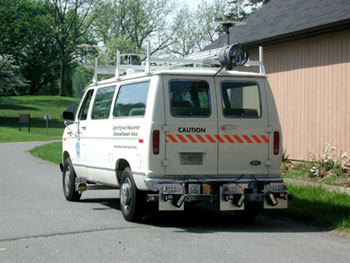 |
| The Digital Highway Measurement van combines a variety of instruments on a single vehicle to provide accurate, efficient analysis of roadway geometry and pavement conditions. |
When a vehicle runs off the road, the driver needs enough room to regain control and steer back onto the road safely. The roadside space should be a clear zone, free of fixed objects that vehicles could hit. If such objects cannot be removed, transportation agencies can install protective devices such as crash cushions or guardrails to minimize the risk of serious injury. Transportation professionals involved in designing roadways that fulfill these requirements need up-to-date information on practices and policies relating to safe roadside design, including criteria for establishing clear zones and choosing appropriate traffic barriers.
To address that need, the National Highway Institute (NHI), the Federal Highway Administration’s training arm, offers a 14-hour online course on roadside design. The course provides an overview of the 2002 American Association of State Highway and Transportation Officials (AASHTO) Roadside Design Guide, an industry reference on safe roadside design. The online course, which can be accessed from a participant’s computer at any time, provides a cost-effective alternative for those who cannot attend NHI’s 2-day, instructor-led course on the same topic.
Both the online and instructor-led versions of the course are designed for Federal, State, local, and consulting highway engineers involved in developing roadside designs or formulating policies and standards related to safer roadsides. During the course, participants will learn to:
Each student receives a copy of the Roadside Design Guide as the course text. The recently published third edition of the guide also is available from AASHTO’s online bookstore at www.transportation.org/publications/bookstore.nsf/Home?OpenForm.
To register for NHI’s online course on roadside design, visit www.nhi.fhwa.dot.gov/home.aspx. For information on the instructor-led course, go to www.nhi.fhwa.dot.gov/home.aspx. For technical information on the course, contact:
Richard Powers 202–366–1320 richard.powers@fhwa.dot.gov
Every day, engineers face new and exciting challenges in transportation, such as determining how to move people and freight securely and efficiently around the Nation and the world. They also plan, develop, and build transportation systems that connect neighborhoods and cities, taking into consideration how various transportation modes—such as highways and mass transit—work together to serve a region’s transportation needs. But if you ask most children what they want to be when they grow up, it is unlikely that many would say they want to become engineers, or envision what engineers do for transportation.
The National Engineers Week Future City Competition™ addresses this information gap by providing middle school students with the experience of solving real-world engineering challenges. Now in its 12th year, this competition promotes interest in engineering by offering seventh and eighth graders an opportunity to participate in hands-on applications of math and science skills and lays the foundation for developing workplace skills such as vision, troubleshooting, and teamwork. More than 1,100 schools and 30,000 students participated in this year’s Future City Competition.
Guided by a teacher and volunteer engineer-mentor, students construct a “city of tomorrow” from the ground up, using SimCity™ software and building a three-dimensional model. In addition, each team writes an abstract about the city’s features and services and an essay on the city’s engineering challenges. The teams must deal with pollution, education, traffic jams, and other real-life problems—all the while maintaining a balanced budget. They present their city design to a panel of judges from the engineering industry, answering questions on details such as the infrastructure, energy sources, and types of technology used.
As part of the annual Future City Competition, the Federal Highway Administration (FHWA) sponsors a special award for the Best Transportation System, which goes to the team that best incorporates transportation elements of moving people and freight in and out of its prototypical future city.
FHWA announced the winner of its special award at the Future City national finals during National Engineers Week (February 22-27, 2004) in Washington, DC. A team from the Valley Middle School in Oakland, NJ, was the winner of the 2004 FHWA award. The Valley students named their city “Glacialis,” after its frigid location in Antarctica. According to the students’ entry abstract, “Citizens of Glacialis use communal teleportation booths located in strategic places for long-distance travel. For short-distance journeys, citizens use Personal Transportation Tube Devices based on pneumatic tube technology developed by transportation engineers.”
Students from Riverview Junior/ Senior High School in Oakmont, PA, won this year’s overall Future City Competition with their city, “Avenir.” The Valley Middle School team, who won FHWA’s transportation award, also placed second in the overall competition. Drexel Middle School in Drexel, PA, won third place; Heritage Middle School in Westerville, OH, took fourth place; and St. Barnabas Catholic School in Chicago, IL, placed fifth.
FHWA sponsors the transportation award to encourage middle school students to consider careers in engineering and transportation, to pro-mote appreciation of the important role of transportation in enhancing quality of life, and to provide insight into the challenges that highway engineers face in developing and maintaining the Nation’s transportation system.
For more information on the Future City Competition or National Engineers Week, visit www.futurecity.org and www.eweek.org.
Martha Soneira 202–493–3468 martha.soneira@fhwa.dot.gov
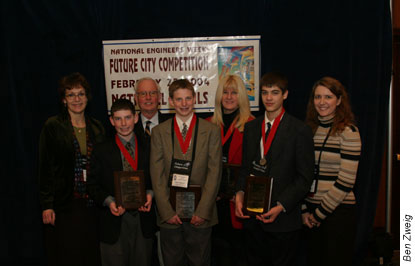 |
| A team from Valley Middle School in Oakland, NJ, won this year’s FHWA Future City Transportation Award. Shown at the award presentation are (left to right): Martha Soneira of FHWA, student Michael Gippetti, engineer-mentor Michael McNally, student James Gippetti, teacher Judith Vihonski, student Mark Reischel, and Deborah Curtis of FHWA. |
Since the passage of the Transportation Equity Act for the 21st Century (TEA-21) in 1998, the program for the Federal Highway Administration’s (FHWA) Office of Federal Lands Highway (FLH) has nearly doubled and may continue to grow pending reauthorization of Federal transportation legislation. Due to this expansion, FLH has been hiring more mid-career professionals who have excellent technical skills but often know little about how FLH operates. In addition, FLH’s partners and customers increasingly are demanding more technical assistance. To meet the demands for assistance and ensure that all new hires understand FLH’s information and processes, the National Highway Institute, with help from FLH and FHWA’s Office of Professional Development, has developed Federal Lands 101 (#310108A), a 3-day course to introduce newly hired employees and others to FLH operations and regulations.
The goal of the course is to explore how FLH functions, including how it administers programs, delivers projects, develops and transfers technology, and provides external training. According to Don Tuggle, director of program administration for FHWA’s Eastern Federal Lands Highway Division, course participants are exposed to the full range of project management and procurement processes used at FLH.
Prior to taking the course, participants typically have little experience in evaluating environmental impacts, financing transportation projects, or otherwise understanding “the things you don’t learn in engineering school,” according to Tuggle. Although most new employees usually have considerable engineering experience, many need to learn more about transportation policy and procedures and other Federal regulations, before administering FLH projects. Upon completing the course, participants will be able to identify the role and authorities of FLH within FHWA. They also will have a greater understanding of how FLH interacts with the Federal-aid division offices in each State. In addition, participants will be able to describe the unique aspects of FLH’s customers and programs, plus the processes and resources that the office uses to deliver projects and conduct business.
The course will benefit employees in all positions and grades within FLH, workers within FHWA’s Federal-aid offices—particularly new hires, and employees from other Federal offices that are affected by FLH work. Most important, the course orients direct hires or employees who join FLH in a mid-level position, who need to learn the culture and procedures of the office very quickly to be effective.
“FLH has a very large percentage of direct hires,” says Tuggle. “We see a critical need to get these new employees educated on the organization as quickly as possible to maximize their individual effectiveness in addressing our organizational goals and workload. Our partner agencies also have expressed the desire to understand more about our organization, so we are hopeful that Federal Lands 101 can help us address both of these needs.”
NHI held a pilot version of the course in Denver, CO, in March 2004. To schedule a session contact Danielle Mathis-Lee at 703–235–0528 or danielle.mathis-lee@fhwa.dot.gov.
Nancy Stout nancy.stout@fhwa.dot.gov
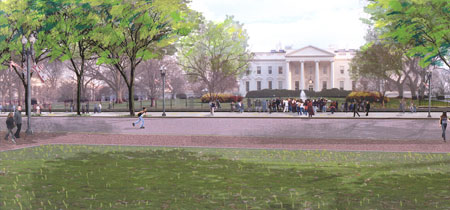 |
| White House in Washington, DC, one of several projects that FHWA’s Office of Federal Lands Highway currently is administering. |
Keeping up with developments in the transportation field can be a challenge for transportation professionals at local highway agencies. Traditional, instructor-led training classes often involve significant time away from the office. In addition, at least 25 States mandate that, for license renewal, an engineering licensee must demonstrate the satisfactory completion of professional development classes.
To help transportation professionals at local agencies access professional development opportunities, the Federal Highway Administration (FHWA) recently purchased 250 registrations for Online Learning Gateway courses—also known as e-learning courses—offered by the Institute of Transportation Engineers (ITE). FHWA sent the registration coupons to each of the Nation’s 51 Local Technical Assistance Program and 7 Tribal Technical Assistance Program centers, who disseminated them—free of charge—to professionals at local agencies. The courses enable coupon recipients to receive hands-on professional training via the Internet, rather than through traditional training in a classroom setting.
The online courses provide interactive, Internet-based training that combines skill-based knowledge with practical applications and examples. The courses can be accessed from a computer, 24 hours a day, and each course takes approximately 4 hours to complete. Those who successfully complete the final test that accompanies each course earn a certificate of completion and six professional development hour units.
ITE currently offers four e-learning courses covering transportation planning, safety, and capacity analysis:
William C. Evans
For more information, visit the E-Learning Center at www.ite.org.
Al Alonzi 703–235–0552 al.alonzi@fhwa.dot.gov
Although the number of crashes occurring during the day is nearly equal to that occurring at night, traffic volumes are significantly lower at night, resulting in about a fourfold increase in the fatal crash rate during nighttime hours over the daytime rate. The primary reason for the difference in crash rates, and the cause of many roadway fatalities, is reduced driving visibility at night.
At the Federal Highway Administration (FHWA), researchers are studying new ways to improve road safety, to prevent crashes caused by poor roadway visibility, and to address the environmental concerns caused by roadway lighting. This new research, along with a history of lighting engineering, was the focus of a recent presentation at Lightfair 2004—a comprehensive trade show and conference devoted to architectural and commercial lighting and technology.
At Lightfair, Richard Stark of ERS Engineering, Ronald Gibbons of the Virginia Tech Transportation Institute (VTTI), and Carl Andersen, manager of FHWA’s Arens Photometric and Visibility Laboratory at the Turner-Fairbank Highway Research Center in McLean, VA, delivered a presentation titled “Roadway Lighting Research—Past, Present, and Future.”
Richard Stark started the presentation and discussed the origins of highway lighting research, from “revealing power”—essentially an early concept of visibility that is now being revisited by some researchers—through work in the 1970s that established visibility as the key factor in crash avoidance, and finally to the first adoption of luminance criteria in the United States in 1983. Ronald Gibbons then presented the current state of visibility research, focusing on work from the early 1980s to the present. During this period, the focus of visibility research shifted toward creating a visual environment that is safe and secure for motorists and other road users. Specifically, transportation researchers began working on enhancing small target visibility—the difference in visibility caused by the luminance of an object in a roadway and the luminance in the object’s background.
Finally, Carl Andersen discussed the future goals of visibility research. According to Andersen and other lighting experts, future visibility research will aim to develop a comprehensive “driver model” that will put the improvements in lighting, setting, and understanding of visibility in the context of human actions. The goal of future research is to predict mathematically how drivers will respond to roadway conditions. To create this model, researchers at FHWA are taking advantage of new developments in technologies used to measure lighting, such as charge-coupled device (CCD) photometers—digital cameras that can measure full field luminance—and new testing grounds, such as the VTTI/Virginia Department of Transportation Smart Road facility, a 9.2-kilometer (5.7-mile), limited-access highway near Blacksburg, VA. The researchers are using the new technologies and facility to characterize a driver’s full field of view under various controlled operating conditions.
The new visibility research is directed at developing more efficient lighting systems for mitigating light pollution and energy use while improving driver safety. The studies are intended to provide policymakers with a better understanding of the costs and benefits of adding lights to roadways. The general consensus among transportation experts, for example, is that adding lighting may reduce crashes by approximately 15 percent. By installing more advanced and energy-efficient lighting on roadways, this crash rate reduction may be achieved at a lower cost, thereby using limited transportation dollars more efficiently.
Carl K. Andersen
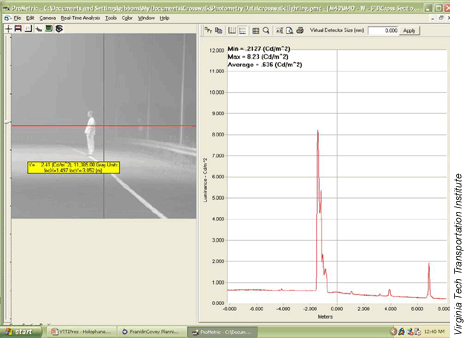 |
| This screen shot of a pedestrian crossing a street, and the corresponding luminance readout, were both produced by CCD camera processing software used in visibility improvement research. |
Transportation professionals who specialize in geotechnical engineering study soil behavior, foundations, ground improvements, and the use of earth retaining systems, embankments, and cut-slope operations. Geotechnical engineers improve the safety and efficiency of highway structures by reducing project costs, accelerating construction time, and developing and deploying improved materials, equipment, specifications, and contracting procedures.
To foster collaboration and information exchange among designers, academics, researchers, and specialty contractors in the geotechnical industry, the Federal Highway Administration’s (FHWA) Geotechnical Team, along with several private organizations, recently sponsored the first Joint International Specialty Conference and Equipment Exposition. The International Association of Foundation Drilling and the American Society of Civil Engineers’ (ASCE) Geo-Institute hosted the event.
Leading manufacturers, suppliers and distributors from around the world exhibited the latest advances in geoconstruction. More than 130 outdoor exhibit spaces enabled attendees to inspect the latest equipment and climb into the cabs of the state-of-the-art rigs. Members of FHWA’s Geotechnical Team participated in the indoor exhibition where more than 80 exhibits representing the geotechnical design and construction community were on display.
Targeted at the consulting, research, academic, construction, and manufacturing communities, the conference featured hundreds of presentations on topics ranging from state-of-the-art designs to state-of-the-practice field applications. The agenda also included career advancement seminars and short training courses.
For example, a presentation by Ali Porbaha, a member of the geotechnical engineering faculty at the California State University in Sacramento, focused on various tools and initiatives for supporting embankment foundations on soft ground. The initiatives include developing design charts for deep mixed columns, introducing new methods of performing quality assessments in the field, and creating a simplified tool to evaluate the uncertainties associated with interpreting the strength and stiffness of soil cement. Porbaha based his presentation on a technical paper that he wrote with Al DiMillio, geotechnical research manager at FHWA’s Turner-Fairbank Highway Research Center.
In another presentation, Joseph Waxse, a member of ASCE, discussed how the Nebraska Department of Roads (NDOR) utilized the slurry method to construct drilled shafts and performed load testing with the Osterberg Load Cell (O-Cell™)—a highly calibrated load testing device that efficiently measures the load capacity of a shaft—to expedite completion and reduce costs on a major bridge project. Incorporation of the load test results enabled NDOR to design the final shaft lengths efficiently. In addition, the department discovered the importance of working with an experienced contractor who uses the appropriate equipment and has procedures for assuring the quality of the work performed.
The conference agenda also included several “Spotlight” plenary sessions on major geotechnical issues affecting the engineering community. One session, for example, featured a discussion on the design-build concept and included executives from large and small general contractors, large and small consulting firms, and FHWA.
Held in Orlando, FL, the conference drew more than 2,100 attendees from around the world.
Peter Osborn 410–962–0702 peter.osborn@fhwa.dot.gov
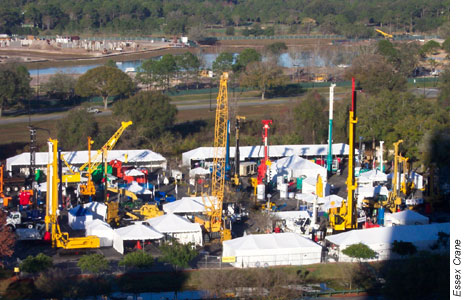 |
| More than 130 indoor and outdoor exhibitors displayed the latest foundation and geosupport technology, such as cranes and other large equipment shown in this aerial photograph, at the Joint International Specialty Conference and Equipment Exposition. |
Using conventional concrete to make prestressed beams for bridge construction can lead to inadequate consolidation of the concrete in reinforced areas, causing entrapped air voids that can compromise the concrete’s strength and durability. Producing conventional concrete also is labor-intensive because it requires vibration from a handheld machine with workers wading through the wet concrete. This mechanical vibration is intended to prevent air voids and ensure a homogeneous mixture.
To minimize these problems, researchers at the Federal Highway Administration (FHWA) are assisting the Virginia Department of Transportation (VDOT) and the Virginia Transportation Research Council in determining if self-consolidating concrete (SCC), which consolidates under its own mass without the use of vibration, could be used to produce prestressed concrete beams. The researchers currently are conducting load tests on four full-size SCC beams for VDOT, which is studying how this relatively new material may be used for bridge construction. In the tests underway at FHWA’s Turner-Fairbank Highway Research Center in McLean, VA, researchers are applying loads to the ends of the four SCC beams until they fail. When the tests are complete, the researchers will compare the results with design capacities produced using the appropriate predictor equations from the governing specifications to determine how accurately current analysis methods approximate SCC behavior.
VDOT asked FHWA to conduct the tests primarily to confirm an adequate development length between the concrete and the steel strands at the ends of the beams. Development length is the distance that a steel reinforcement must be embedded in the concrete to prevent it from pulling out when the beam is stressed. Since SCC is different from conventional concrete, the researchers are concerned that it could bond differently to the steel tendons.
The use of SCC has the potential to provide savings in bridge construction due to lower labor costs. The reduced likelihood of large air voids in SCC, which should allow the material to last longer, could result in even further savings.
Bob Kogler
For more information on the beam tests, contact:
Bill Wright 202–493–3053 bill.wright@fhwa.dot.gov
 |
| A load is placed on an I-shaped beam made of self-consolidating concrete to determine adequate development length between the concrete and the steel strands shown protruding from the end of the beam. |